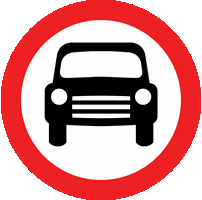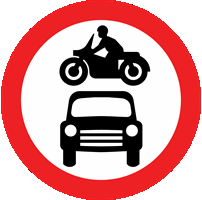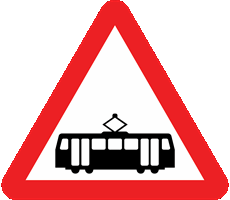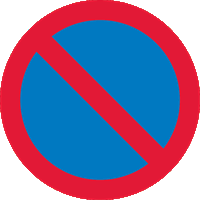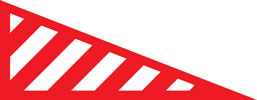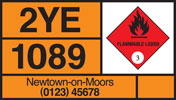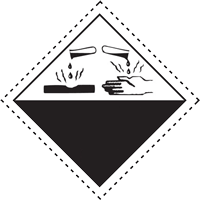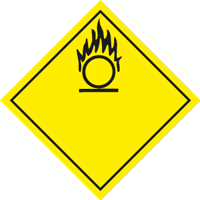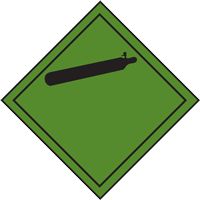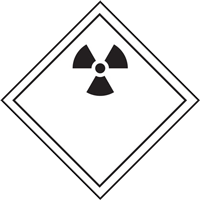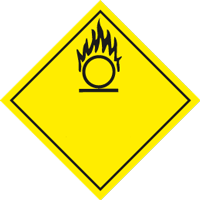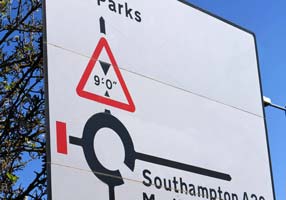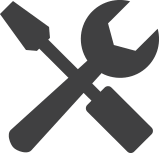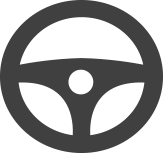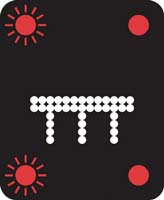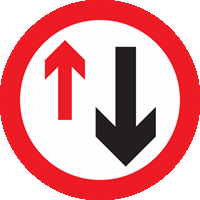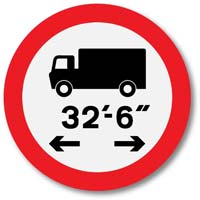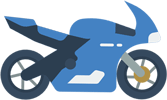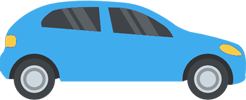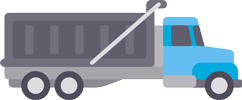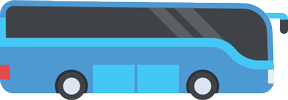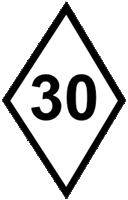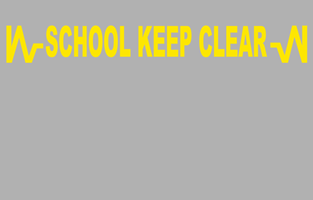You have 115 minutes (1 hour 55 minutes) to answer 100 multiple choice LGV theory test questions. You must score at least 85 out of 100 to pass the test. Answers may be checked after each question or you can wait until the end of the test to view your results. Best of luck!
Test Quick View
Click on an answer to view the correct choice along with the explanation.
Correct Answer: D
Explanation: Traffic-calming measures are becoming more common. Look out for signs warning you of humps in the road ahead. If necessary, change your route rather than take risks.
Explanation: Traffic-calming measures are becoming more common. Look out for signs warning you of humps in the road ahead. If necessary, change your route rather than take risks.
2. What should you do if you need to unload a delivery but there are double red lines at the destination?
Mark one answer
B
C
D
Correct Answer: C
Explanation: White boxes allow you to unload at any time, but during the day the length of stay is restricted. You should check nearby signs for the specific times. At other times, when it's not so busy, there may not be any restrictions on parking.
Explanation: White boxes allow you to unload at any time, but during the day the length of stay is restricted. You should check nearby signs for the specific times. At other times, when it's not so busy, there may not be any restrictions on parking.
B
C
D
Correct Answer: B
Explanation: The type of suspension fitted to a vehicle will influence its resistance to 'roll-over'. Modern tri-axle semi-trailers fitted with single wheels on each side extend the tracking width available, making this the most stable configuration.
Explanation: The type of suspension fitted to a vehicle will influence its resistance to 'roll-over'. Modern tri-axle semi-trailers fitted with single wheels on each side extend the tracking width available, making this the most stable configuration.
Correct Answer: B
Explanation: If you're using a vehicle equipped with an analogue tachograph, you'll need at least one chart for every 24 hours. Your employer should supply you with enough tachograph charts for your entire journey.
Explanation: If you're using a vehicle equipped with an analogue tachograph, you'll need at least one chart for every 24 hours. Your employer should supply you with enough tachograph charts for your entire journey.
Correct Answer: A
Explanation: If your current tachograph chart becomes damaged, you should start another and then attach it to the damaged one. Your records must be clear and up to date at all times. It's sensible to carry more tachograph charts than you think you'll need for your journey. Then you'll be able to use a spare if one becomes dirty or damaged.
Explanation: If your current tachograph chart becomes damaged, you should start another and then attach it to the damaged one. Your records must be clear and up to date at all times. It's sensible to carry more tachograph charts than you think you'll need for your journey. Then you'll be able to use a spare if one becomes dirty or damaged.
Correct Answer: C
Explanation: Be careful of giving lifts to strangers; some employers actively discourage it. Allowing strangers in your cab or telling people about your load could put the security of your vehicle and load at risk, and may put you in danger.
Explanation: Be careful of giving lifts to strangers; some employers actively discourage it. Allowing strangers in your cab or telling people about your load could put the security of your vehicle and load at risk, and may put you in danger.
B
C
D
Correct Answer: D
Explanation: Theft of loads from commercial vehicles is a serious problem. You should take steps to safeguard your load when leaving the vehicle overnight. Simply parking with the rear doors close to another vehicle or a wall can act as an effective deterrent to thieves.
Explanation: Theft of loads from commercial vehicles is a serious problem. You should take steps to safeguard your load when leaving the vehicle overnight. Simply parking with the rear doors close to another vehicle or a wall can act as an effective deterrent to thieves.
8. How should you react if you're losing tread from a tyre while driving on a motorway?
Mark one answer
B
C
D
Correct Answer: C
Explanation: Continuous high speeds on the motorway can cause the tyres to become hot and to shred. If you notice this happening, you must stop on the hard shoulder as soon as it's safe to do so. It's dangerous to drive a defective vehicle.
Explanation: Continuous high speeds on the motorway can cause the tyres to become hot and to shred. If you notice this happening, you must stop on the hard shoulder as soon as it's safe to do so. It's dangerous to drive a defective vehicle.
9. What feature of a site is most important when looking for a place to park your trailer?
Mark one answer
B
C
D
Correct Answer: B
Explanation: Check that the ground is firm and level before you uncouple the trailer. If you need to, place a heavy plank under the legs to distribute the weight and stop the legs sinking into the ground. Don't park illegally. Make sure that your unattended trailer isn't blocking access for others.
Explanation: Check that the ground is firm and level before you uncouple the trailer. If you need to, place a heavy plank under the legs to distribute the weight and stop the legs sinking into the ground. Don't park illegally. Make sure that your unattended trailer isn't blocking access for others.
Correct Answer: C
Explanation: Hitting a bridge with your vehicle can have serious consequences for road and rail traffic. You must tell the police about the incident immediately. If the bridge is a railway bridge, call the railway authority as well as the police to report the incident.
Explanation: Hitting a bridge with your vehicle can have serious consequences for road and rail traffic. You must tell the police about the incident immediately. If the bridge is a railway bridge, call the railway authority as well as the police to report the incident.
11. What's the first thing you should you do if there is a fire in the engine compartment?
Mark one answer
B
C
D
Correct Answer: C
Explanation: If you suspect a fire, try to isolate the source. If possible, disconnect electrical leads and cut off the fuel supply.
Explanation: If you suspect a fire, try to isolate the source. If possible, disconnect electrical leads and cut off the fuel supply.
12. What's the maximum speed limit for a vehicle with a maximum authorised mass (MAM) of 10 tonnes on a single carriageway?
Mark one answer

B
C
D
Correct Answer: B
Explanation: The national speed limit for a goods vehicle exceeding 7.5 tonnes on a single carriageway road in England and Wales is 50 mph. In Scotland, the limit is 40 mph. The national speed limit varies for different vehicle categories. You must know the limit that applies to the vehicle you're driving.
Explanation: The national speed limit for a goods vehicle exceeding 7.5 tonnes on a single carriageway road in England and Wales is 50 mph. In Scotland, the limit is 40 mph. The national speed limit varies for different vehicle categories. You must know the limit that applies to the vehicle you're driving.
B
C
D
Correct Answer: B
Explanation: No motor vehicles are allowed past this sign. Although a motorcycle and car are shown, the restriction applies to all motor vehicles.
Explanation: No motor vehicles are allowed past this sign. Although a motorcycle and car are shown, the restriction applies to all motor vehicles.
Correct Answer: A
Explanation: It's important that you always select a place to park that's both safe and legal. Don't park on or too close to a pedestrian crossing or a school entrance; this would restrict the view for drivers and pedestrians. Don't park at a bus stop either, because buses would then have to stop in the road, creating a hazard for other traffic and for passengers getting on or off the bus.
Explanation: It's important that you always select a place to park that's both safe and legal. Don't park on or too close to a pedestrian crossing or a school entrance; this would restrict the view for drivers and pedestrians. Don't park at a bus stop either, because buses would then have to stop in the road, creating a hazard for other traffic and for passengers getting on or off the bus.
15. Which of the following should be displayed on an LGV with a maximum authorised mass (MAM) of more than 7.5 tonnes?
Mark one answer
B
C
D
Correct Answer: C
Explanation: Motor vehicles over 7500 kg maximum authorised mass (MAM) and trailers over 3500 kg MAM should have these markings fitted to the rear of the vehicle/trailer.
Explanation: Motor vehicles over 7500 kg maximum authorised mass (MAM) and trailers over 3500 kg MAM should have these markings fitted to the rear of the vehicle/trailer.
16. What should be completed on the centre field of the tachograph chart at the start of your shift?
Mark one answer
B
C
D
Correct Answer: B
Explanation: Before starting your journey, you must record a number of items on your tachograph chart. One of these is where the journey begins.
Explanation: Before starting your journey, you must record a number of items on your tachograph chart. One of these is where the journey begins.
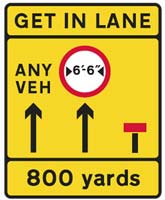
B
C
D
Correct Answer: C
Explanation: At motorway roadworks, some lanes may be narrower than normal and large vehicles may not be allowed to use those lanes. Look for weight-limit signs to check for any lanes that you can't use. Move to the appropriate lane in good time.
Explanation: At motorway roadworks, some lanes may be narrower than normal and large vehicles may not be allowed to use those lanes. Look for weight-limit signs to check for any lanes that you can't use. Move to the appropriate lane in good time.
Correct Answer: D
Explanation: Goods vehicles exceeding 2500 kg laden weight must always have their parking lights switched on when they're parked on the road at night. This includes parking in lay-bys: other drivers entering the lay-by must be able to see the vehicle.
Explanation: Goods vehicles exceeding 2500 kg laden weight must always have their parking lights switched on when they're parked on the road at night. This includes parking in lay-bys: other drivers entering the lay-by must be able to see the vehicle.
Correct Answer: D
Explanation: The driver mustn't allow any cargo to be damaged during transit, loading or unloading. This requires a responsible attitude to safeguard the load at all times.
Explanation: The driver mustn't allow any cargo to be damaged during transit, loading or unloading. This requires a responsible attitude to safeguard the load at all times.
Correct Answer: B
Explanation: If you're driving an articulated vehicle or a trailer combination, it's vital that you understand the rules that apply to coupling and uncoupling the brake lines. If you take a practical driving test with a trailer, you'll be expected to demonstrate this during the test. The lines are colour-coded: red is the emergency line, blue is the auxiliary line and yellow is the service line. They must be connected strictly in accordance with the correct procedure.
Explanation: If you're driving an articulated vehicle or a trailer combination, it's vital that you understand the rules that apply to coupling and uncoupling the brake lines. If you take a practical driving test with a trailer, you'll be expected to demonstrate this during the test. The lines are colour-coded: red is the emergency line, blue is the auxiliary line and yellow is the service line. They must be connected strictly in accordance with the correct procedure.
Correct Answer: B
Explanation: On a hot day, the fuel in your tank will expand. If this happens when the tank has been filled to the brim, fuel will spill onto the road. This can be very dangerous or even fatal for other road users - especially motorcyclists. Allow for this expansion when filling your tank.
Explanation: On a hot day, the fuel in your tank will expand. If this happens when the tank has been filled to the brim, fuel will spill onto the road. This can be very dangerous or even fatal for other road users - especially motorcyclists. Allow for this expansion when filling your tank.
22. Why might you tie the curtain sides at one end of the vehicle when driving a curtain-sided vehicle?
Mark one answer
B
C
D
Correct Answer: C
Explanation: Closed curtains on large empty vehicles can hold the wind. Strong side wind can blow a semi-trailer off course and, in severe cases, can blow the whole vehicle over onto its side. To reduce the risk of this happening, you should tie the curtains open.
Explanation: Closed curtains on large empty vehicles can hold the wind. Strong side wind can blow a semi-trailer off course and, in severe cases, can blow the whole vehicle over onto its side. To reduce the risk of this happening, you should tie the curtains open.
B
C
D
Correct Answer: B
Explanation: In windy weather, exposed stretches of road may have lane closures or there may be diversions for some types of vehicle. Consider this when you're planning your journey; delays will add to your driving time.
Explanation: In windy weather, exposed stretches of road may have lane closures or there may be diversions for some types of vehicle. Consider this when you're planning your journey; delays will add to your driving time.
Correct Answer: B
Explanation: Always make a final check in your mirrors and check your blind spots before you turn. Another driver or a motorcyclist may have committed themselves to overtaking traffic behind you before realising you intend to turn.
Explanation: Always make a final check in your mirrors and check your blind spots before you turn. Another driver or a motorcyclist may have committed themselves to overtaking traffic behind you before realising you intend to turn.
25. Who should you get advice from if you're regularly transporting high-value loads?
Mark one answer
B
C
D
Correct Answer: A
Explanation: High-value cargoes are often targeted by thieves. Operators are recommended to seek advice from their local crime-prevention officer to help prevent their vehicles and loads from being stolen.
Explanation: High-value cargoes are often targeted by thieves. Operators are recommended to seek advice from their local crime-prevention officer to help prevent their vehicles and loads from being stolen.
Correct Answer: B
Explanation: The full name of the CMR is the 'Convention on the Contract for the International Carriage of Goods by Road'. You'll need this document to transport goods internationally by road. Of the four copies required, the consignor, consignee and originator all have one copy, and the fourth travels with the vehicle.
Explanation: The full name of the CMR is the 'Convention on the Contract for the International Carriage of Goods by Road'. You'll need this document to transport goods internationally by road. Of the four copies required, the consignor, consignee and originator all have one copy, and the fourth travels with the vehicle.
27. What should you do if you need to park and unload a 7.5 tonne vehicle on a verge?
Mark one answer
B
C
D
Correct Answer: B
Explanation: Goods vehicles with a maximum authorised mass of more than 7.5 tonnes (including any trailer) mustn't be parked on a verge without police permission. The only exception is when this is essential for loading and unloading. In these cases, the vehicle mustn't be left unattended.
Explanation: Goods vehicles with a maximum authorised mass of more than 7.5 tonnes (including any trailer) mustn't be parked on a verge without police permission. The only exception is when this is essential for loading and unloading. In these cases, the vehicle mustn't be left unattended.
Correct Answer: C
Explanation: A fifth wheel must be maintained properly. It requires regular lubrication and inspection. This should be carried out monthly or every 10 000 km - whichever comes first.
Explanation: A fifth wheel must be maintained properly. It requires regular lubrication and inspection. This should be carried out monthly or every 10 000 km - whichever comes first.
Correct Answer: C
Explanation: Overloading an axle has an impact on the environment, causing damage to road surfaces. You also risk a fine and driving penalties.
Explanation: Overloading an axle has an impact on the environment, causing damage to road surfaces. You also risk a fine and driving penalties.
Correct Answer: A
Explanation: If you're carrying a high-value load, you should consider your personal safety. There's always the possibility of an attempted theft. Watch out for and report anything unusual, such as people taking a special interest in you or your vehicle.
Explanation: If you're carrying a high-value load, you should consider your personal safety. There's always the possibility of an attempted theft. Watch out for and report anything unusual, such as people taking a special interest in you or your vehicle.
31. After loading timber into a lorry, which sheets should you start with when covering the load?
Mark one answer
B
C
D
Correct Answer: C
Explanation: When more than one sheet is used to cover and protect a load, the rear sheet should be positioned first. This is so that the overlaps face backwards, rather than forwards, preventing wind and rain from getting between the sheets.
Explanation: When more than one sheet is used to cover and protect a load, the rear sheet should be positioned first. This is so that the overlaps face backwards, rather than forwards, preventing wind and rain from getting between the sheets.
B
C
D
Correct Answer: C
Explanation: Vehicles carrying dangerous or hazardous goods need to have markings on them that clearly identify the load. This could, for example, help the emergency services to deal with any incident quickly and safely.
Explanation: Vehicles carrying dangerous or hazardous goods need to have markings on them that clearly identify the load. This could, for example, help the emergency services to deal with any incident quickly and safely.
Correct Answer: C
Explanation: The symbols on the back or side of a lorry should show the type of material that the vehicle will normally be carrying.
Explanation: The symbols on the back or side of a lorry should show the type of material that the vehicle will normally be carrying.
Correct Answer: B
Explanation: As the lubricating oil is pumped around the engine, it collects tiny fragments of metal from the moving parts. The oil filter is designed to remove these fragments. Most filters are designed to be replaced at service intervals.
Explanation: As the lubricating oil is pumped around the engine, it collects tiny fragments of metal from the moving parts. The oil filter is designed to remove these fragments. Most filters are designed to be replaced at service intervals.
Correct Answer: D
Explanation: Chilled foods are transported at temperatures above freezing point. Drivers need to be trained in hygiene procedures and how to operate refrigeration units.
Explanation: Chilled foods are transported at temperatures above freezing point. Drivers need to be trained in hygiene procedures and how to operate refrigeration units.
36. In which of the following might vehicles over a certain length be restricted from entering?
Mark one answer
B
C
D
Correct Answer: C
Explanation: Look out for restrictions on long vehicles. Length restrictions are found where there isn't much room to turn (for example, in a tunnel) or where there's a risk of grounding.
Explanation: Look out for restrictions on long vehicles. Length restrictions are found where there isn't much room to turn (for example, in a tunnel) or where there's a risk of grounding.
Correct Answer: A
Explanation: Look out for signs giving you advance warning of height restrictions. As a professional driver, you should always know the height of your vehicle or load. If you aren't sure of the safe height, stop and check.
Explanation: Look out for signs giving you advance warning of height restrictions. As a professional driver, you should always know the height of your vehicle or load. If you aren't sure of the safe height, stop and check.
Correct Answer: D
Explanation: It's essential that all wheel nuts are tightened to the specified torque with a calibrated torque wrench. The wheel nuts, fixings and markers should be checked every day before you start your journey.
Explanation: It's essential that all wheel nuts are tightened to the specified torque with a calibrated torque wrench. The wheel nuts, fixings and markers should be checked every day before you start your journey.
Correct Answer: D
Explanation: A tachograph allows you to select the mode or task that you're undertaking. Time spent on that task is then recorded automatically. Each task has a different symbol. You need to know the meaning of each, so that your records are correct. The modes are: driving, doing other work, on duty and available for work, and taking a break or rest.
Explanation: A tachograph allows you to select the mode or task that you're undertaking. Time spent on that task is then recorded automatically. Each task has a different symbol. You need to know the meaning of each, so that your records are correct. The modes are: driving, doing other work, on duty and available for work, and taking a break or rest.
Correct Answer: B
Explanation: If you're driving for long distances on a motorway, have plenty of rest stops. Many incidents have been caused by drivers falling asleep at the wheel. If you feel yourself becoming tired, you need to leave the motorway and find a safe place to stop; usually this would be the next service area.
Explanation: If you're driving for long distances on a motorway, have plenty of rest stops. Many incidents have been caused by drivers falling asleep at the wheel. If you feel yourself becoming tired, you need to leave the motorway and find a safe place to stop; usually this would be the next service area.
B
C
D
Correct Answer: A
Explanation: If you don't give your name and address at the time of an incident, report it to the police as soon as you can, or in any case within 24 hours. If any other person is injured and you don't produce your insurance certificate to the police at the time of the incident, or to any other person who has reasonable grounds to request it, you must also
Explanation: If you don't give your name and address at the time of an incident, report it to the police as soon as you can, or in any case within 24 hours. If any other person is injured and you don't produce your insurance certificate to the police at the time of the incident, or to any other person who has reasonable grounds to request it, you must also
- report the incident to the police as soon as possible, or in any case within 24 hours
- produce your insurance certificate to the police either when reporting the incident or within seven days (five days in Northern Ireland) at any police station.
Correct Answer: D
Explanation: You can help someone suffering from shock by talking to them and reassuring them confidently. Don't leave them alone or give them anything to eat or drink.
Explanation: You can help someone suffering from shock by talking to them and reassuring them confidently. Don't leave them alone or give them anything to eat or drink.
43. Why would you move an unconscious casualty that is still breathing following an accident?
Mark one answer
B
C
D
Correct Answer: A
Explanation: Moving a casualty could cause further injury, so it's important that this is only done if there's danger to them where they are.
Explanation: Moving a casualty could cause further injury, so it's important that this is only done if there's danger to them where they are.
Correct Answer: B
Explanation: When driving large vehicles, windscreen pillars and large mirrors can easily create blind spots as you look left and right at junctions. Altering your body position slightly while looking into the new road can give you an improved view of the traffic. If in doubt, look again and reassess the situation. Don't take chances.
Explanation: When driving large vehicles, windscreen pillars and large mirrors can easily create blind spots as you look left and right at junctions. Altering your body position slightly while looking into the new road can give you an improved view of the traffic. If in doubt, look again and reassess the situation. Don't take chances.
Correct Answer: A
Explanation: By using a bypass, rather than joining the stop/start traffic in a town centre, you're less likely to be held up and can travel at a constant speed. Keeping to a constant speed will reduce the amount of pollution produced by your vehicle.
Explanation: By using a bypass, rather than joining the stop/start traffic in a town centre, you're less likely to be held up and can travel at a constant speed. Keeping to a constant speed will reduce the amount of pollution produced by your vehicle.
Correct Answer: C
Explanation: Fuel spilled on the road is a serious danger to other road users, especially motorcyclists. To prevent this from happening, make sure the filler cap is secure after refuelling.
Explanation: Fuel spilled on the road is a serious danger to other road users, especially motorcyclists. To prevent this from happening, make sure the filler cap is secure after refuelling.
Correct Answer: A
Explanation: When the red lights are flashing, don't go beyond this signal. This sign shows that all lanes ahead are closed and you mustn't enter the motorway. Motorway signals are located on the central reservation, to the left of the hard shoulder, on overhead gantries and at the entrance to the motorway.
Explanation: When the red lights are flashing, don't go beyond this signal. This sign shows that all lanes ahead are closed and you mustn't enter the motorway. Motorway signals are located on the central reservation, to the left of the hard shoulder, on overhead gantries and at the entrance to the motorway.
Correct Answer: C
Explanation: When you see this sign, you must give way to traffic from the opposite direction, regardless of the size of your vehicle.
Explanation: When you see this sign, you must give way to traffic from the opposite direction, regardless of the size of your vehicle.
Correct Answer: D
Explanation: You need to know the length of your vehicle as well as its weight, height and width. Places where the length of your vehicle may be relevant are
Explanation: You need to know the length of your vehicle as well as its weight, height and width. Places where the length of your vehicle may be relevant are
- road tunnels
- level crossings
- ferries
- bridges.
B
C
D
Correct Answer: D
Explanation: In wet conditions, water can build up between your tyres and the road surface. This is known as aquaplaning and it will cause your vehicle to slide. Try to regain control by easing off the accelerator to gradually lose speed. Don't brake or steer until your tyres are gripping the road again.
Explanation: In wet conditions, water can build up between your tyres and the road surface. This is known as aquaplaning and it will cause your vehicle to slide. Try to regain control by easing off the accelerator to gradually lose speed. Don't brake or steer until your tyres are gripping the road again.
Correct Answer: B
Explanation: Tyres have codes shown on the wall of the tyre. These refer to the maximum load and speed capability of the tyre.
Explanation: Tyres have codes shown on the wall of the tyre. These refer to the maximum load and speed capability of the tyre.
Correct Answer: B
Explanation: Your vehicle will make more noise than a car, so you should try to avoid making unnecessary noise at any time of the day or night. This is especially important when you're in a residential area at a time when people are likely to be sleeping.
Explanation: Your vehicle will make more noise than a car, so you should try to avoid making unnecessary noise at any time of the day or night. This is especially important when you're in a residential area at a time when people are likely to be sleeping.
53. Which of the following medical conditions might stop you from getting a bus or lorry license?
Mark one answer
B
C
D
Correct Answer: C
Explanation: An illness that could affect you while you're driving, such as a heart condition, may make it unsafe for you to drive. You must tell DVLA if you develop any serious illness or disability that's likely to last more than three months and that could affect your driving. Partial blindness and mental disorders can also prevent you from getting a driving licence for large vehicles.
Explanation: An illness that could affect you while you're driving, such as a heart condition, may make it unsafe for you to drive. You must tell DVLA if you develop any serious illness or disability that's likely to last more than three months and that could affect your driving. Partial blindness and mental disorders can also prevent you from getting a driving licence for large vehicles.
Correct Answer: C
Explanation: When your steering wheels are locked - as can happen in a skid - you can't steer the vehicle. Anti-lock brakes help you to keep steering control while you're braking heavily, but they aren't a substitute for good forward planning. Anticipation and planning ahead will minimise the risk of skidding more effectively than relying on your braking system.
Explanation: When your steering wheels are locked - as can happen in a skid - you can't steer the vehicle. Anti-lock brakes help you to keep steering control while you're braking heavily, but they aren't a substitute for good forward planning. Anticipation and planning ahead will minimise the risk of skidding more effectively than relying on your braking system.
B
C
D
Correct Answer: B
Explanation: The car is the most stable of the vehicles shown. However, all vehicles are affected by side wind and buffeting from larger vehicles. Be aware that your speed and road position could cause unnecessary turbulence when passing smaller vehicles.
Explanation: The car is the most stable of the vehicles shown. However, all vehicles are affected by side wind and buffeting from larger vehicles. Be aware that your speed and road position could cause unnecessary turbulence when passing smaller vehicles.
Correct Answer: A
Explanation: During high winds, one of the lanes on a high bridge might be closed to traffic to create a buffer lane. The buffer lane is kept free to prevent vehicles from being blown into the path of other road users in the next lane. The closure of this lane may cause traffic congestion and delay.
Explanation: During high winds, one of the lanes on a high bridge might be closed to traffic to create a buffer lane. The buffer lane is kept free to prevent vehicles from being blown into the path of other road users in the next lane. The closure of this lane may cause traffic congestion and delay.
57. Which of the following type of vehicle is likely to be most affected by your vehicle as a result of turbulence?
Mark one answer
B
C
D
Correct Answer: B
Explanation: remember that the buffeting caused by large vehicles can affect other road users, including
Explanation: remember that the buffeting caused by large vehicles can affect other road users, including
- cars towing caravans
- motorcyclists.
Correct Answer: B
Explanation: In very windy conditions, certain types of vehicle can be blown off course. These include box vans, curtain-siders, caravans and motorcycles. Make allowances for how the wind might affect these vehicles, especially if you're overtaking.
Explanation: In very windy conditions, certain types of vehicle can be blown off course. These include box vans, curtain-siders, caravans and motorcycles. Make allowances for how the wind might affect these vehicles, especially if you're overtaking.
59. Where should you be especially wary of side winds when driving a high-sided vehicle on a motorway?
Mark one answer
B
C
D
Correct Answer: D
Explanation: On motorways, be especially careful when driving over bridges and viaducts. The road here is exposed and in windy weather there's a risk of strong side wind, which may blow you off course or even blow your vehicle over. In severe windy weather, these routes are often closed to drivers of high-sided vehicles.
Explanation: On motorways, be especially careful when driving over bridges and viaducts. The road here is exposed and in windy weather there's a risk of strong side wind, which may blow you off course or even blow your vehicle over. In severe windy weather, these routes are often closed to drivers of high-sided vehicles.
60. How could faulty spray-suppression equipment negatively affect other drivers in wet conditions?
Mark one answer
B
C
D
Correct Answer: D
Explanation: Spray-suppression equipment reduces the amount of spray thrown up to other road users. Check the equipment regularly to make sure it's secure and undamaged.
Explanation: Spray-suppression equipment reduces the amount of spray thrown up to other road users. Check the equipment regularly to make sure it's secure and undamaged.
61. What might cause your steering to feel less responsive while driving in heavy rain on the motorway?
Mark one answer
B
C
D
Correct Answer: A
Explanation: If a build-up of water prevents the tyres from gripping the road, the steering can become unresponsive. If this happens, ease off the accelerator and slow down gradually.
Explanation: If a build-up of water prevents the tyres from gripping the road, the steering can become unresponsive. If this happens, ease off the accelerator and slow down gradually.
62. What should you do if you see the brake air-pressure warning light when you start driving?
Mark one answer
B
C
D
Correct Answer: C
Explanation: Even though the warning light is showing, there may be sufficient pressure to release the parking brake. However, you mustn't do this, because there may not be enough air pressure to operate the service brake.
Explanation: Even though the warning light is showing, there may be sufficient pressure to release the parking brake. However, you mustn't do this, because there may not be enough air pressure to operate the service brake.
Correct Answer: A
Explanation: Pedestrians use push-button controls to activate the signals. Pelican crossings have no red-and-amber stage before green. Instead, they have a flashing amber light. This means you must give way to pedestrians on the crossing, but you may proceed if the crossing is clear.
Explanation: Pedestrians use push-button controls to activate the signals. Pelican crossings have no red-and-amber stage before green. Instead, they have a flashing amber light. This means you must give way to pedestrians on the crossing, but you may proceed if the crossing is clear.
Correct Answer: D
Explanation: When traffic is heavy, plan well ahead so that you don't block crossings. Leave them clear so that pedestrians can cross safely.
Explanation: When traffic is heavy, plan well ahead so that you don't block crossings. Leave them clear so that pedestrians can cross safely.
B
C
D
Correct Answer: C
Explanation: Tiredness can seriously affect your concentration - even to the point of falling asleep. You always need to be alert so that you can safely deal with the constantly changing environment around your vehicle.
Explanation: Tiredness can seriously affect your concentration - even to the point of falling asleep. You always need to be alert so that you can safely deal with the constantly changing environment around your vehicle.
66. What should you do if you're offered alcohol at an event, but will be driving home later?
Mark one answer
B
C
D
Correct Answer: B
Explanation: Avoiding alcohol will always be the safest option. There are many factors that influence how alcohol will affect you, such as height, weight and gender. It's better not to risk a single alcoholic drink before you drive.
Explanation: Avoiding alcohol will always be the safest option. There are many factors that influence how alcohol will affect you, such as height, weight and gender. It's better not to risk a single alcoholic drink before you drive.
67. Why should you ask your doctor whether you can drive safely after being given medicine?
Mark one answer
B
C
D
Correct Answer: B
Explanation: Some medicines can have side-effects that affect your driving. Ask your doctor whether you'll be safe to drive while taking the medicine that's been prescribed.
Explanation: Some medicines can have side-effects that affect your driving. Ask your doctor whether you'll be safe to drive while taking the medicine that's been prescribed.
B
C
D
Correct Answer: D
Explanation: Never drive after taking drugs you don't know about. They might affect your judgement and perception - and, therefore, endanger lives.
Explanation: Never drive after taking drugs you don't know about. They might affect your judgement and perception - and, therefore, endanger lives.
69. How should you react to a large vehicle joining the motorway from a slip road to your left?
Mark one answer
B
C
D
Correct Answer: A
Explanation: It's not always possible for drivers in the left-hand lane to change lanes to let joining traffic merge. However, you should be ready to adjust your speed to help the joining driver merge safely.
Explanation: It's not always possible for drivers in the left-hand lane to change lanes to let joining traffic merge. However, you should be ready to adjust your speed to help the joining driver merge safely.
70. In which direction should you expect cyclists positioned in the left lane on approach to a roundabout to go in?
Mark one answer
B
C
D
Correct Answer: A
Explanation: When following cyclists onto a roundabout, be aware that they might not take the exit you expect them to. Cyclists approaching in the left-hand lane may be turning right. They may not have been able to get into the correct lane due to heavy traffic, so give them room.
Explanation: When following cyclists onto a roundabout, be aware that they might not take the exit you expect them to. Cyclists approaching in the left-hand lane may be turning right. They may not have been able to get into the correct lane due to heavy traffic, so give them room.
Correct Answer: A
Explanation: Learners might take longer to react to traffic situations. Don't unnerve and intimidate them by driving up close behind.
Explanation: Learners might take longer to react to traffic situations. Don't unnerve and intimidate them by driving up close behind.
Correct Answer: B
Explanation: Don't hurry elderly people across the road by getting too close to them or revving the engine. Be aware that they might take longer to cross. They might also have hearing difficulties and not hear you approaching.
Explanation: Don't hurry elderly people across the road by getting too close to them or revving the engine. Be aware that they might take longer to cross. They might also have hearing difficulties and not hear you approaching.
73. What should you do if you want to turn into a side up ahead on your left but there is a cyclist in front of you?
Mark one answer
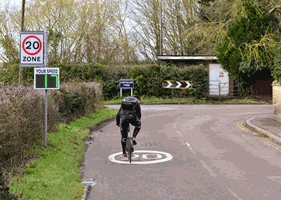
B
C
D
Correct Answer: D
Explanation: Make allowances for cyclists. Allow them plenty of room, and be aware that they also have to deal with hazards. They might swerve or change direction suddenly to avoid uneven road surfaces.
Explanation: Make allowances for cyclists. Allow them plenty of room, and be aware that they also have to deal with hazards. They might swerve or change direction suddenly to avoid uneven road surfaces.
Correct Answer: C
Explanation: Continuous use of the brakes on a long downhill gradient can cause them to overheat and become ineffective. This is called brake fade. You should use a low gear to enable the engine's braking effect to help control your speed. Also use the vehicle's retarder, if fitted. As well as reducing the likelihood of brake fade, this helps to keep air pressure in the tanks.
Explanation: Continuous use of the brakes on a long downhill gradient can cause them to overheat and become ineffective. This is called brake fade. You should use a low gear to enable the engine's braking effect to help control your speed. Also use the vehicle's retarder, if fitted. As well as reducing the likelihood of brake fade, this helps to keep air pressure in the tanks.
Correct Answer: B
Explanation: In good dry conditions, you should leave a two-second gap between your vehicle and the one ahead. When the weather is bad, you'll have to keep a greater distance, because it will take you longer to stop. In wet weather it will take up to twice the distance; in icy weather this could increase to ten times as far.
Explanation: In good dry conditions, you should leave a two-second gap between your vehicle and the one ahead. When the weather is bad, you'll have to keep a greater distance, because it will take you longer to stop. In wet weather it will take up to twice the distance; in icy weather this could increase to ten times as far.
76. What might it mean if the driver of a lorry flashes their headlights while you're overtaking them?
Mark one answer
B
C
D
Correct Answer: C
Explanation: Never presume what someone means when they flash their headlights, as they might be signalling to someone else. Use your own judgement and wait until it's safe to complete your manoeuvre.
Explanation: Never presume what someone means when they flash their headlights, as they might be signalling to someone else. Use your own judgement and wait until it's safe to complete your manoeuvre.
Correct Answer: D
Explanation: Drinking alcohol will reduce your ability to drive safely. One drink is too many if you're going to drive.
Explanation: Drinking alcohol will reduce your ability to drive safely. One drink is too many if you're going to drive.
Correct Answer: D
Explanation: Trams are becoming increasingly common in large towns and cities, as the move to more environmentally friendly transport continues. They may either cross the road you're driving on or share it with you. Always be aware of their virtually silent approach, and look out for places where you may be required to give way to them.
Explanation: Trams are becoming increasingly common in large towns and cities, as the move to more environmentally friendly transport continues. They may either cross the road you're driving on or share it with you. Always be aware of their virtually silent approach, and look out for places where you may be required to give way to them.
79. How could a tyre blow-out on your vehicle be potentially hazardous for other drivers?
Mark one answer
B
C
D
Correct Answer: A
Explanation: When a tyre explodes, fragments are thrown over a wide area. This can create a serious hazard for other drivers. You should regularly check your tyres for cuts, damage and pressure. Frequent checks and proper maintenance can help prevent a blow-out.
Explanation: When a tyre explodes, fragments are thrown over a wide area. This can create a serious hazard for other drivers. You should regularly check your tyres for cuts, damage and pressure. Frequent checks and proper maintenance can help prevent a blow-out.
Correct Answer: D
Explanation: The entrances to roundabouts are often worn. This can make the surface slippery, especially when it's wet. You should plan your approach and brake in good time.
Explanation: The entrances to roundabouts are often worn. This can make the surface slippery, especially when it's wet. You should plan your approach and brake in good time.
81. What might happen if you begin to overtake another vehicle on an uphill gradient while driving a fully laden vehicle?
Mark one answer
B
C
D
Correct Answer: A
Explanation: Always plan well ahead before overtaking. Take into consideration the size of your vehicle and whether there's a gradient ahead. The load on your vehicle will slow you down on an uphill gradient. It may be better to wait until you're on the level before trying to overtake.
Explanation: Always plan well ahead before overtaking. Take into consideration the size of your vehicle and whether there's a gradient ahead. The load on your vehicle will slow you down on an uphill gradient. It may be better to wait until you're on the level before trying to overtake.
82. Which of the following can you refer to for help with carrying out minor repairs to your vehicle?
Mark one answer
B
C
D
Correct Answer: C
Explanation: The vehicle handbook will clearly explain what maintenance may be carried out by the driver. Always refer to it and comply with the safety guidance that it contains. However, you need to be aware of your employer's policy on making any minor repairs.
Explanation: The vehicle handbook will clearly explain what maintenance may be carried out by the driver. Always refer to it and comply with the safety guidance that it contains. However, you need to be aware of your employer's policy on making any minor repairs.
83. For what reason can you sound your horn if you're in a built-up area between 11.30 pm and 7.00 am?
Mark one answer
B
C
D
Correct Answer: D
Explanation: The horn shouldn't be used between 11.30 pm and 7.00 am in a built-up area. The only exception is when another road user is unaware of you and poses a danger.
Explanation: The horn shouldn't be used between 11.30 pm and 7.00 am in a built-up area. The only exception is when another road user is unaware of you and poses a danger.
84. How should you approach a zebra crossing which has a disabled pedestrian waiting to cross?
Mark one answer
B
C
D
Correct Answer: C
Explanation: Prepare to slow down and stop, as you would for a person without a disability. Don't wave them across, as other traffic may not stop.
Explanation: Prepare to slow down and stop, as you would for a person without a disability. Don't wave them across, as other traffic may not stop.
85. What should you do if there is a slow-moving but unpredictable motorcyclist riding in front of you?
Mark one answer
B
C
D
Correct Answer: D
Explanation: The motorcyclist might be turning right, changing direction or unsure of their destination. Stay behind until the rider has made a move or you're sure you can pass safely. Don't intimidate them by moving too close.
Explanation: The motorcyclist might be turning right, changing direction or unsure of their destination. Stay behind until the rider has made a move or you're sure you can pass safely. Don't intimidate them by moving too close.
Correct Answer: A
Explanation: Parking on the yellow zigzag lines will block the view of the school entrance. This will endanger the lives of children wanting to cross the road on their way to and from school.
Explanation: Parking on the yellow zigzag lines will block the view of the school entrance. This will endanger the lives of children wanting to cross the road on their way to and from school.
Correct Answer: B
Explanation: Smart motorways are intended to reduce congestion and make journey times more reliable. In these areas, the hard shoulder may be used as a running lane to ease congestion at peak times or when an incident occurs. The variable speed limits shown in red circles are mandatory and help to keep traffic flowing at a steady speed.
Explanation: Smart motorways are intended to reduce congestion and make journey times more reliable. In these areas, the hard shoulder may be used as a running lane to ease congestion at peak times or when an incident occurs. The variable speed limits shown in red circles are mandatory and help to keep traffic flowing at a steady speed.
Correct Answer: A
Explanation: When a smart motorway is in operation, you must follow the instructions shown on the gantries above each lane. There may also be instructions above the hard shoulder. The signals displayed are mandatory and may be enforced with camera technology.
Explanation: When a smart motorway is in operation, you must follow the instructions shown on the gantries above each lane. There may also be instructions above the hard shoulder. The signals displayed are mandatory and may be enforced with camera technology.
Correct Answer: B
Explanation: Print or write down your route before setting out. Some places aren't well signed, so using both place names and road numbers may help you avoid getting lost. Find out how far you'll be travelling and plan your rest stops into the route.
Explanation: Print or write down your route before setting out. Some places aren't well signed, so using both place names and road numbers may help you avoid getting lost. Find out how far you'll be travelling and plan your rest stops into the route.
Correct Answer: B
Explanation: By driving smoothly, you'll reduce fuel consumption by about 15%, and you'll reduce the amount of wear and tear on your vehicle. You'll also feel more relaxed and have a more pleasant journey.
Explanation: By driving smoothly, you'll reduce fuel consumption by about 15%, and you'll reduce the amount of wear and tear on your vehicle. You'll also feel more relaxed and have a more pleasant journey.
Correct Answer: B
Explanation: If convicted, the current fine for each illegal immigrant brought into the UK is £2000. This fine can be imposed on each responsible person; this includes the vehicle driver, owner and hirer.
Explanation: If convicted, the current fine for each illegal immigrant brought into the UK is £2000. This fine can be imposed on each responsible person; this includes the vehicle driver, owner and hirer.
Correct Answer: A
Explanation: Being as healthy and alert as possible will make you safer on the road. Take regular meal and rest breaks, and keep to foods that contain complex carbohydrates, such as bread and vegetables. These release energy slowly and will keep you satisfied for longer than foods with a high sugar content.
Explanation: Being as healthy and alert as possible will make you safer on the road. Take regular meal and rest breaks, and keep to foods that contain complex carbohydrates, such as bread and vegetables. These release energy slowly and will keep you satisfied for longer than foods with a high sugar content.
Correct Answer: A
Explanation: Concentration will be improved by eating regular, light meals timed to fit in with your scheduled rest periods. If you don't eat at all, your blood sugar levels will drop and you'll feel tired. If you just eat snack foods, most of which are sugary or high in fat, your energy levels will peak and then drop - and eating while you're driving is a dangerous distraction.
Explanation: Concentration will be improved by eating regular, light meals timed to fit in with your scheduled rest periods. If you don't eat at all, your blood sugar levels will drop and you'll feel tired. If you just eat snack foods, most of which are sugary or high in fat, your energy levels will peak and then drop - and eating while you're driving is a dangerous distraction.
94. What type of digital tachograph card do police and law enforcement officers have unlimited access to?
Mark one answer
B
C
D
Correct Answer: B
Explanation: Various types of smart card are used in digital tachograph systems:
Explanation: Various types of smart card are used in digital tachograph systems:
- driver card, used by drivers
- company card, used by operators
- workshop card, available only to approved calibration centres
- control card, available only to Driver and Vehicle Standards Agency (DVSA) officials and the police, for carrying out enforcement.
95. Which of the following might be inspected by the environmental health department during a roadside check?
Mark one answer
B
Correct Answer: B
Explanation: Local-authority environmental health departments check vehicles' exhaust emissions. They have the power to prosecute the driver and the operator, as do enforcement bodies such as DVSA.
Explanation: Local-authority environmental health departments check vehicles' exhaust emissions. They have the power to prosecute the driver and the operator, as do enforcement bodies such as DVSA.
Correct Answer: A
Explanation: Driving in an ecosafe manner means that you plan well ahead for hazards and react in good time. This can save fuel and is therefore good for the environment.
Explanation: Driving in an ecosafe manner means that you plan well ahead for hazards and react in good time. This can save fuel and is therefore good for the environment.
97. In which of these circumstances would it be permissible to drive without a seat belt?
Mark one answer
B
C
D
Correct Answer: B
Explanation: When seat belts are fitted to your vehicle, they must be worn unless you hold a valid medical exemption certificate. People making deliveries or collections in goods vehicles are also exempt, when they're travelling less than 50 metres (162 feet).
Explanation: When seat belts are fitted to your vehicle, they must be worn unless you hold a valid medical exemption certificate. People making deliveries or collections in goods vehicles are also exempt, when they're travelling less than 50 metres (162 feet).
B
C
D
Correct Answer: D
Explanation: Using air conditioning continuously can increase fuel consumption by about 15%. Think of the environment and only use it when it's necessary.
Explanation: Using air conditioning continuously can increase fuel consumption by about 15%. Think of the environment and only use it when it's necessary.
99. What should you do with your tachograph chart if you move from one vehicle to another with the same type of tachograph?
Mark one answer
B
C
D
Correct Answer: C
Explanation: When changing vehicles, you should also record certain pieces of information, including the closing odometer reading, the registration number of the new vehicle, the odometer start reading and the time of the vehicle change.
Explanation: When changing vehicles, you should also record certain pieces of information, including the closing odometer reading, the registration number of the new vehicle, the odometer start reading and the time of the vehicle change.
100. How often should an analogue tachograph be inspected at an approved tachograph calibration centre?
Mark one answer
B
C
D
Correct Answer: C
Explanation: An analogue tachograph must be checked every two years and recalibrated and sealed every six years. This must be done at an approved calibration centre. Digital tachographs, unlike analogue ones, must be recalibrated every two years.
Explanation: An analogue tachograph must be checked every two years and recalibrated and sealed every six years. This must be done at an approved calibration centre. Digital tachographs, unlike analogue ones, must be recalibrated every two years.



